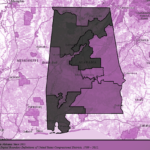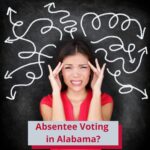This is the tenth article of a 10 part series on redistricting + apportionment + gerrymandering, in relation to Alabama.
If you’ve read through the entire sequential set of posts, we hope that you’re now feeling relieved that you understand what’s going on and that the League is ON THE CASE as far as federal Congressional districts go. But then, immediately, you’re thinking: but what about all of the state-level districts?? If the Permanent Committee on Reapportionment of our legislature is also responsible for redrawing all of those districts, how can we keep track of their efforts to make sure that the new maps are fair? We noted above that it will be important for us to scrutinize the committee’s redistricting guidelines and follow their application to assess their ability to stop gerrymandering.
We are working with partners to monitor and track these state-level redistricting processes and to propose our own maps. We will refer to these as “community redistricting” and we will emphasize that what we do will affect our lives directly, in relation to allocation of funds for essential services.
A key concept here, listed among the League standards for redistricting in part eight of this series, is “communities of interest.” It is important to note that whereas a community of interest can be defined in many ways, race and ethnicity can play a role in defining a COI but cannot be used as the sole definition. Residents may have a shared ancestry, history, or language. A community of interest is a neighborhood, community, or group of people who have common policy concerns and would benefit from being maintained in a single district.
Another way of understanding a community of interest is that it is simply a way for a community to tell its own story about what neighbors share in common, and what makes it unique when compared to surrounding communities. Communities of Interest are defined by the local community members. Examples of communities of interest might be: residents working together to advocate for a local health clinic; community members advocating to get assistance to repair their neighborhood after a natural disaster; a neighborhood organizing to have a high school built closer to their area; a community celebrating cultural holidays, like Lunar New Year or Dia de los Muertos; neighbors who are advocating for the closure of a nearby coal plant.
Keeping communities of interest together is an important principle in redistricting. It can be especially helpful to communities that have been traditionally left out of the political process. Community members can define their communities by telling their own stories and describe their concerns to policy makers. Without this, those who may not have their best interest in mind will define the communities for them.
Representable is a free mapping tool specifically designed to assist in identifying and mapping communities of interest.
There are also free guides and videos on the internet on how to use Representable to create COIs and shape your or your community group’s public testimony.
A smaller sample of the census data, the “American Community Survey,” may be useful for state-level redistricting processes, as discussed in this report from the Brennan Center:
As noted above, the best course of action for private citizens and representatives of community groups is to attend a public hearing and present testimony on how district lines would affect them and their community. View the schedule of hearings around the state on the Committee’s website under meetings and notices.
We will provide more information as it becomes available, including training materials on how to prepare both written testimony and an oral version of that testimony for a committee hearing.
We close this series with several important ideas that we hope you will carry with you:
- Voter registration efforts are of course essential, but if partisans are drawing the lines to affect an election result, it dilutes those noble efforts.
- The bottom line is fairness, because elected leaders are inevitably less responsive to the full range of their constituents if their district is reliably “safe” in partisan terms.
- A final important idea, related to the health of democracy as a whole, is that gerrymandering is a corrupting influence on both parties, and that both parties actually benefit from a competitive system instead of one that is rigged to promote ideological extremism and guarantee incumbency.
This series is a joint effort of the blog editor, Catherine Davies, and other members of the Advocacy Team and Board of the League of Women Voters of Alabama.


